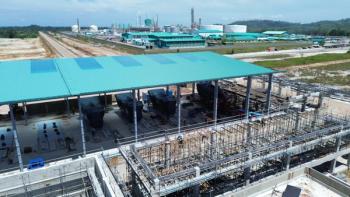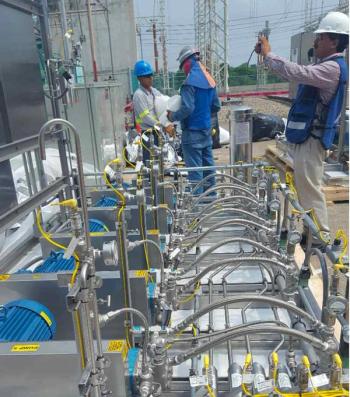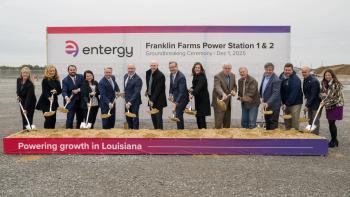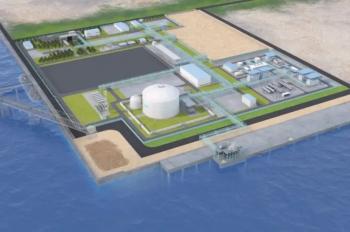
Industry News
MHI buys Pratt & Whitney Power Systems
It has been a while since a major power generation OEM was acquired. But a mega-deal happened in December when Mitsubishi Heavy Industries (MHI) concluded an agreement with United Technologies Corporation (UTC) of the U.S. under which MHI will acquire Pratt & Whitney Power Systems (PWPS), the small and medium-size gas turbine business unit of Pratt & Whitney (P&W).
PWPS produces aeroderivative gas turbines as well as servicing power generation equipment. The company’s 430 employees, as well as those of Turboden of Italy (maker of Organic Rankine Cycle turbines) become part of MHI.
Intent on broadening its aeroderivative power generation portfolio, MHI is gaining a greater presence in North America where PWPS is strongest. Up to now, MHI has focused its gas turbine business principally on large-capacity, high-efficiency systems. Another reason for MHI’s move could be to be better able to support flexible power sources complementary to renewable energy.
The relationship between the companies is not new. They have been involved in a collaborative relationship in aeroengine production for many years, including recent joint development of the new jet engine for the Mitsubishi Regional Jet. However, the question remains as to where UTC is headed. In an interview with Peter Christman, President of PWPS, (May/June2012, p. 42), Christman stated that the company was divesting its Rocketdyne, Clipper Windpower and three Hamilton Sundstrand businesses. Coal gasification as well as solar power will go with the Rocketdyne business, he said.
PWPS recently entered into an arrangement to have Wood Group GTS service its fleet of FT4 aeroderivative turbines (July/August2012, p. 23). It remains to be seen how this partnership will be impacted by the MHI purchase. “It is a significant step in UTC’s ongoing portfolio transformation,” said Pratt & Whitney President, David Hess. “Pratt & Whitney Power Systems is a solid company with many talented employees and we are pleased to place it with a company that will provide it with the resources and capabilities for future growth.”
Controls upgrade for Klamath
ABB has commissioned a Symphony control system upgrade for the Pratt & Whitney FT8 TwinPac turbines located at Iberdrola’s Klamath Cogeneration Facility. This included the design and implementation of enhanced control logic and graphics, development of a surge-protection module and start-up. ABB takes the approach of replacing proprietary black box controls with an open architecture. “We made vast improvements to the availability, reliability and overall performance of the units.” said Ray Martens, Plant Managing Director, Iberdrola.
Puerto Rican controls
Invensys Operations Management completed a controls upgrade at 12 Puerto Rico Electric Power Authority (PREPA) sites. With 5,839 MW of generating capacity, PREPA is one of the largest public utilities in the U.S. and the sole provider of electricity for 1.5 million people in Puerto Rico.
Invensys supplied its Foxboro I/A Series distributed control system, including its new Foxboro Control Software solution, to help PREPA diversify its production capabilities and add renewable energy to its power mix. Invensys also provided field service and start-up support, as well as design, testing and implementation services.
PREPA’s total production capacity is expected to grow to 6,719 MW by 2014. As a result, it has undertaken a multi-phase initiative to expand gas firing at all its generating plants. To meet U.S. EPA hazardous air pollutant criteria, 12% of PREPA’s total output will have to come from renewable sources by 2015. The number increases to 15% by 2020 and to 20% by 2035. PREPA’s current modernization initiative will provide the company with an automation infrastructure that will make it easier to integrate renewable fuels into its power production line.
NAES contract
NAES Corporation’s Turbine Services Division has been awarded a contract to provide on-site support services for a major inspection of Unit #6 at the GenOn Chalk Point Generating Station in Prince George’s County, Maryland. Unit #6 is a 4-stage combustion gas turbine rated at 100 MW. NAES received the order from Precision Gas Turbine (PGT) of Plantation, Florida to supply supervision, millwrights, welders and both standard and metric tooling trailers as a subcontractor to PGT. The customer supplied scope includes complete disassembly and reassembly of the turbine, including upending and de-stacking the turbine rotor (at site). Scheduled to start in January 2013, the project is expected to span five months.
GE jobs
GE added 115 jobs this year at its production facilities in Slater, MO. The company also plans to invest nearly $11 million to improve the facilities. “Expanding our workforce and facilities are vital to driving our filtration business to support natural gas power generation in North America,” said Keith White, general manager of GE Power & Water’s Air Filtration business.
Colfax pumps to Russia
Colfax Fluid Handling delivered a package of 21 Allweiler screw and centrifugal pumps for a bitumen production facility in Russia. The facility is located in Novoshakhtinsk (Rostov region) and produces bitumen according to the “Biturox” process from Vienna-based Pörner Ingenieurgesellschaft.
The 13 Allweiler screw pumps of the SNH series and 8 centrifugal pumps of the CNH-B, CTWH, and NTWH series will go into service in early 2013. The pumps will move bitumen, residue products, water and heat transfer oils. Pumps used in high-temperature applications above 150°C will utilize double-jacket casings for heating with superheated steam. These pumps permit stable operation up to a pumping temperature of 270°C. They are also dirt resistant, efficient and ensure high uptime. Hard coating of the screws and surface treatment of inner walls are said to extend service life.
OEM partnership
Hitachi and MHI have reached a basic agreement on integrating their thermal power generation systems, and jointly managing these operations. The two companies plan to begin a joint venture company by January 1, 2014. MHI and Hitachi will take equity interests of 65% and 35%, respectively. Earlier partnerships between the two companies include steel production machinery, railway systems and hydroelectric power. Based on earlier successes together, integration in thermal power generation will soon begin. MHI focuses on large models while Hitachi provides small and medium-sized models.
MHI has strengths mainly in Southeast Asia and the Middle East, while Hitachi is strong in Europe and Africa.
Energy storage system
In a joint project with SSE plc (formerly Scottish and Southern Energy plc), MHI will begin an energy storage system demonstration project using the power grid in the UK’s Orkney Islands, which has a high proportion of renewable energy generation in relation to demand. The project aims at demonstrating power supply stabilization in the region by introducing a cargo container-type, largecapacity energy storage system using a lithium- ion rechargeable battery, which has a maximum power output capacity of 2 MW. The storage system is slated to be handed over for operational use in early 2013.
The energy storage system has the capacity to store about 800 kWh nominal, 500 kWh normal usage. It consists of two 40ft-long container units for the batteries and a 40ft-long container unit for the power conditioning system. Each battery container houses more than 2,000 units of lithium-ion rechargeable batteries. The power conditioning container houses a system for conversion of direct current, alternating current and the associated input and output controls.
The energy storage system will be installed at the Kirkwall Power Station. In the cases of slight power shortage or surplus, power is transmitted to and from the mainland of Scotland through a submarine cable. When there is too much renewable energy, exceeding the export capacity of the cable to the mainland, the energy storage system will import some of the excess energy, reducing the need to constrain renewable generation at that time.
Chilean power
MHI has received a turnkey order from Empresa Eléctrica Guacolda S.A. (Guacolda), an electricity provider in Chile, for a 154 MW coal-fired power generation plant to be built in Huasco, Atacama Region. The plant marks the fifth unit ordered from MHI by Guacolda, following earlier orders for the 150 MW No.1 and No.2 units and for the 152 MW No. 3 and 4 units. The No. 5 unit is scheduled to go on-stream in September 2015. The plant will be built in Huasco, some 700 kilometers north of Santiago. It will be situated adjacent to the four units previously delivered by MHI, and will consist of a boiler, steam turbine, generator, steam condenser, and removal systems for SOx and NOx and particulate.
Pumps for Zambia
Sulzer Pumps has a contract for the supply of 12 large dewatering pump sets for a copper mine in Zambia. The scope includes the design, manufacture, testing, packaging, installation, supervision and commissioning of ten high-pressure HPH pumps with 3,000 kW motors for continuous dewatering of the main shaft, and two small medium pressure HPH pumps with 800 kW motors for emergency pumping situations. The high-pressure pumps produce heads in the range of 1,275 m each.
The project location is close to Sulzer Pumps’ Zambian service center in Chingola. The 12 pump sets will be manufactured at Sulzer Pumps’ facility in Elandsfontein, South Africa, with commissioning of the shaft currently scheduled in 2014.
Turkish refinery
GE will provide equipment and services for a plant upgrade of the Izmit Tupras refinery, located on the Gulf of Izmit in Turkey. GE will supply two Frame 6B gas turbines, one steam turbine and three generators to Técnicas Reunidas of Spain, the engineering, procurement and construction contractor for the Izmit Tupras upgrade project. The equipment contract also includes performance testing, services, spare parts and technical advisors. GE also has signed a contractual service agreement to provide maintenance services to Tupras for 12 years.
The GE (SANC1-6 model) 109K-250 VHP steam turbine package for the Tupras upgrade features heavy-duty reaction technology. The cogeneration plant for the Izmit Tupras refinery expansion will begin commercial operation in the first quarter of 2014.
Coal gasification
Synthesis Energy Systems (SES) has entered into an agreement with an undisclosed technology provider to define a product that integrates the SES gasification technology with the provider’s globally deployed process. The agreement calls for SES to lead an engineering study that will outline the optimal integration of these two technologies, leading to an ability to utilize low quality coal as a feedstock. This will be followed by the completion of a basic engineering package and budgetary cost estimate for the integrated plant.
Norway’s largest steam turbine
MAN Diesel & Turbo has supplied a steam turbine generator set for a melting plant belonging to the Norwegian company Finnfjord AS, enabling the plant to increase its energy efficiency by around 40%. Given an electricity output of 40 MW, the turbine set is used to generate electricity from waste heat in the production process.
Lying north of the Arctic Circle, the Finnfjord AS plant produces ferro-silicon, a supplementary material for manufacturing steel and cast iron. Having invested a total of 100 million Euros, this makes it the world’s most efficient ferro-silicon production plant.
The key technology behind this aim is Norway’s largest steam turbine, a complete steam turbine and generator set, supplied, installed, and commissioned for the first time by MAN Diesel & Turbo.
Chinese agreement
GE has signed a long-term Contractual Service Agreement (CSA) with Huaneng Jinling Power Thermal Generation Co., Ltd. This agreement will support a new natural gas-fired combined cycle power plant at Jinling, Nanjing, located in Jiangsu Province. Two 186 MW 9E gas turbines are powering the new facility. Under the CSA, GE will support its equipment for 9 to 12 years. The 9E units and associated equipment, supplied in July 2012, are scheduled to start operation in early 2013.
Centrax Siemens package
Centrax has commissioned its first Siemens CX400 package. This 12 MW unit is meeting 40% of the hot water demand of the French city of Versailles, on the outskirts of Paris, while also producing electricity for sale to French power utility EDF. The combined heat and power installation at Versailles is the first Siemens gas turbine to be packaged by Centrax since the two companies forged a recent agreement that enables Centrax to market the SGT-300 and -400 gas turbines in the UK, France, Italy, the Netherlands and Belgium. The CX400 also gives Centrax a commercial advantage of providing the greatest power output and energy efficiency below the 12 MW cap imposed on co-generation projects in France.
Belgium power plant operations
NAES has assumed operations of T-Power, a 425 MW combined cycle power plant located in Tessenderlo, Belgium, which is about 40 miles east of Brussels. T-Power is owned by ITOCHU, Siemens Project Ventures, Tessenderlo Chemie and Tokyo Gas, and entered service in June 2011. T-Power features single-shaft technology, dispatched via a tolling agreement, and is the first independent power plant in Belgium.
Pumps for PetroChina
Sulzer Pumps will supply 40 pumps to PetroChina for the Guangxi Oil Refinery Project, Phase II. Located in the Guangxi Province in Southern China, the project will refine imported high-sulfur crude, with a total annual capacity of 10 million tons. The project includes 12 pumps for the residue hydro-desulfurization unit, 18 pumps for the diesel oil hydro-treating unit, and 10 pumps for the oil storage and transportation unit and utility unit. Guangxi Oil Refinery Project Phase II is scheduled for operation in October 2013.
Rockwell toolkit
Rockwell Automation has introduced the Connected Components Accelerator Toolkit (CCAT) control design and implementation. The CCAT combines a controller with a suite of compatible components and application development tools that enable OEMs to focus engineering and development resources on creating machine features. This speeds common design functions that every machine design requires using preconfigured building blocks.
MHI M501J landmark
A M501J gas turbine manufactured by Mitsubishi Heavy Industries (MHI), installed in a gas turbine combinedcycle (GTCC) validation power plant at the company’s Takasago Machinery Works, has achieved two landmarks. It exceeded an accumulated 8,000 hours in operation as well as making more than 100 starts. The turbine, featuring an inlet temperature of 1,600°C, went into operation in February 2011, when long-term validation got underway.
MHI has raised its M501J performance specifications for future offerings. Upward revisions include gas turbine output increased to 327 MW, GT efficiency of 41% and combined-cycle efficiency of 61.5%, with a one-on-one single- shaft configuration. Similarly, specifications for the 50 Hz M701J gas turbine have been changed to 470 MW output, and efficiencies of 41% and 61.7%. Some 16 units of the M501J have been sold in Japan and South Korea. Two units of the M701J have been sold, both in Japan.
Newsletter
Power your knowledge with the latest in turbine technology, engineering advances, and energy solutions—subscribe to Turbomachinery International today.





